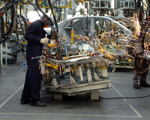We were recently called in to help with controlling the noise levels at an engine test facility. I went to the site to take noise measurements in various areas of the facility. The problem was not within the test cells, but from all the external equipment needed to run the cells from air compressors, to dynamometer drives, to engine exhaust vents. The sound levels were not above the OSHA requirements but were definitely loud enough to warrant some noise mitigation. So what are the key considerations for industrial facility noise control?
When dealing with industrial noise mitigation, if possible, the goal is to control the noise at the source by modifying the equipment itself or replacing it with a quieter model. However, in this case the problem wasn’t necessarily any one piece of equipment, but the overall effect of all the equipment running at the same time. When you can’t modify the equipment itself, the next best options are to block and absorb the sound. For this application, we recommended both. Blocking the sound was fairly straight forward. The supporting equipment for the test cells was primarily on the 2nd floor of the facility. By closing off most of the 2nd floor, the sound levels on the 1st floor could be significantly reduced. An acoustical ceiling solution for the 1st floor was also recommended, to further improve the acoustical environment. Where it wasn’t possible to close off the 2nd floor, we recommended noise isolation enclosures around specific equipment. These enclosures have absorptive material facing the equipment to help absorb and block the sound.
Although each industrial facility presents a unique set of challenges, the basic strategies are the same: control the noise at the source, block the noise, and absorb the noise.
At Acoustics By Design, we design comprehensive noise control solutions for industrial facilities of all kinds. Our professional engineers provide recommendations that solve even the most complex noise issues.
